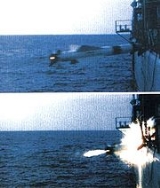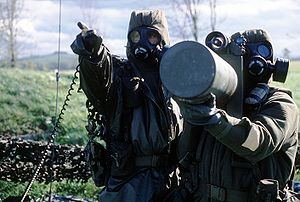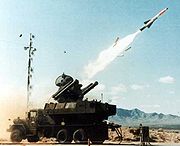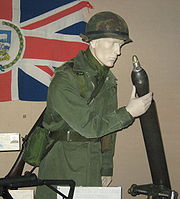
Weapons of the Falklands War
Encyclopedia
Anti-ship missiles
The Exocet is probably the most famous weapon of the war, sinking two British ships and damaging a third. The missile was used by the Argentine NavyArgentine Navy
The Navy of the Argentine Republic or Armada of the Argentine Republic is the navy of Argentina. It is one of the three branches of the Armed Forces of the Argentine Republic, together with the Army and the Air Force....
either air launched from Dassault Super Étendard
Dassault Super Étendard
The Dassault-Breguet Super Étendard is a French carrier-borne strike fighter aircraft designed for service with the French Navy...
jets and from an improvised land launcher.
-
- See main article ExocetExocetThe Exocet is a French-built anti-ship missile whose various versions can be launched from surface vessels, submarines, helicopters and fixed wing aircraft. Hundreds were fired in combat during the 1980s.-Etymology:...
.
- See main article Exocet
The Sea Skua was a British light anti-ship missile, fired from Lynx
Westland Lynx
The Westland Lynx is a British multi-purpose military helicopter designed and built by Westland Helicopters at its factory in Yeovil. Originally intended as a utility craft for both civil and naval usage, military interest led to the development of both battlefield and naval variants...
helicopters, its warhead is only 20 kg compared with the Exocet's 165 kg. However hits from three Sea Skua missiles badly damaged the Argentine ARA Alferez Sobral.
-
- See main article Sea SkuaSea SkuaThe Sea Skua is a British lightweight short-range air-to-surface missile designed for use from helicopters against ships. It is primarily used by the Royal Navy on the Westland Lynx helicopter, although Kuwait uses it in a shore battery and on their Umm Al Maradem fast attack craft.The British...
.
- See main article Sea Skua
The AS.12 was a French built light anti-ship missile, fired from Westland Wasp
Westland Wasp
The Westland Wasp was a British small first-generation, gas-turbine powered, shipboard anti-submarine helicopter. Produced by Westland Helicopters, it came from the same P.531 programme as the British Army Westland Scout, and was based on the earlier piston-engined Saunders-Roe Skeeter...
helicopters. Like the Sea Skua its small 28 kg warhead meant that it could not destroy ships outright, however it could disable smaller vessels. On 25 April 1982 it contributed towards damaging and disabling the Argentine Submarine
Submarine
A submarine is a watercraft capable of independent operation below the surface of the water. It differs from a submersible, which has more limited underwater capability...
the ARA Santa Fe. A total of nine missiles were fired at the submarine trapped on the surface by anti-submarine torpedoes circling just under the hull. Of the missiles fired four hit, four missed and one failed to launch. Two of the missiles that hit the target failed to detonate on impact, instead punching a hole through the slender conning tower and exploding on the far side.
-
- See main article AS.12.
Surface to air missiles
Sea Dart was the British naval medium range Surface to air missile. It proved unable to engage low altitude targets, such as Argentine A4 Skyhawk aircraft and Exocet missiles. However it did achieve several long range kills.-
- See main article Sea Dart missileSea Dart missileSea Dart or Guided Weapon System 30 is a British surface-to-air missile system designed by Hawker Siddeley Dynamics and built by British Aerospace from 1977...
- See main article Sea Dart missile
Sea Wolf is a British naval short range low altitude surface to air missile, used to complement the longer range Sea Dart. It proved capable of engaging low flying aircraft.
-
- See main article Sea Wolf missileSea Wolf missileSea Wolf is a naval guided missile system designed and built by BAC, later to become British Aerospace Dynamics . It is an automated point-defence weapon system designed as a final line of defence against both sea-skimming and high angle anti-ship missiles and aircraft...
- See main article Sea Wolf missile
Seacat and Tigercat surface to air missiles were obsolete by the Falklands War, however they were used by both sides during the conflict. The optically guided missiles were not effective, no kills can be attributed to the missiles. However they could be used in San Carlos Water where radar based systems like Sea Dart and Sea Wolf could not operate. Argentine land forces had a number of Tigercat missile launchers, there were several near misses, and possibly one Sea Harrier
BAE Sea Harrier
The British Aerospace Sea Harrier is a naval VTOL/STOVL jet fighter, reconnaissance and attack aircraft, a development of the Hawker Siddeley Harrier. It first entered service with the Royal Navy in April 1980 as the Sea Harrier FRS1 and became informally known as the "Shar"...
had its engine damaged by shrapnel from one of the missiles.
-
- See main article Sea Cat missileSea Cat missileSea Cat was a British short-range surface to air missile system intended to replace the ubiquitous Bofors 40 mm gun aboard warships of all sizes. It was the world's first operational shipboard point-defence missile system and was designed so that the Bofors guns could be replaced with minimum...
- See main article Sea Cat missile
Sea Slug, a long range, high altitude anti-aircraft missile system of the 1950s, was not used against aircraft but for bombardment of positions near Port Stanley by the Royal navy ships equipped with it.
-
- See main article Sea Slug missileSea Slug missileSea Slug was a first generation surface-to-air missile designed by Armstrong Whitworth for use by the Royal Navy...
- See main article Sea Slug missile

Aermacchi MB-339
The Aermacchi MB-339 is an Italian military trainer and light attack aircraft. It was developed as a replacement for the earlier MB-326.-Design and development:...
that was shot down at Goose Green
Goose Green
Goose Green is a settlement in Lafonia on East Falkland in the Falkland Islands. It lies on Choiseul Sound, on the east side of the island's central isthmus, south-southwest of Darwin. With a population of about 70, it is the second largest settlement of the Falkland Islands.Goose Green has a shop...
on 28 May 1982. Argentine forces shot down a Harrier GR3 on 21 May, probably with a Blowpipe missile fired by Primer Teniente S Fernandez of Commando Company 601 over Port Howard. The systems overall lack of success was probably due to the amount of operator input required to successfully hit a target.
-
- See main article Blowpipe missileBlowpipe missileThe Shorts Blowpipe is a man-portable surface-to-air missile which was in use with the British Army and Royal Marines from 1975. It was superseded by an interim design, Javelin, and later the greatly improved Starstreak missile.-Description:...
- See main article Blowpipe missile
British SAS special forces had acquired 6 American made Stinger missiles, however the Soldier trained to use the missile was killed in a helicopter crash. By luck the first missile fired managed to bring down a Pucará
FMA IA 58 Pucará
The FMA IA 58 Pucará is an Argentine ground-attack and counter-insurgency aircraft. It is a low-wing two-turboprop-engined all-metal monoplane with retractable landing gear, manufactured by the Fábrica Militar de Aviones.-Development:...
on 21 May, however the lack of training meant that a further 5 missiles fired that day did not hit their targets.
-
- See main article FIM-92 StingerFIM-92 StingerThe FIM-92 Stinger is a personal portable infrared homing surface-to-air missile , which can be adapted to fire from ground vehicles and helicopters , developed in the United States and entered into service in 1981. Used by the militaries of the U.S...
- See main article FIM-92 Stinger
Argentine forces used Soviet made SA-7 Grail man portable missiles.
-
- See main article SA-7 Grail

-
- See main article Roland (air defence)Roland (air defence)The Roland is a Franco-German mobile short-range surface-to-air missile system. The Roland was also purchased by the U.S. Army as one of very few foreign SAM systems....
.
- See main article Roland (air defence)
Anti-aircraft guns
Argentine forces deployed a substantial number of anti-aircraft guns around StanleyStanley, Falkland Islands
Stanley is the capital and only true cityin the Falkland Islands. It is located on the isle of East Falkland, on a north-facing slope in one of the wettest parts of the islands. At the 2006 census, the city had a population of 2,115...
and Goose Green airfields and these included 15 Oerlikon GDF-002 35 mm twin cannons
Oerlikon 35 mm twin cannon
The Oerlikon 35 mm twin cannon is a towed anti-aircraft gun made by Oerlikon Contraves . The system was originally designated as 2 ZLA/353 ML but this was later changed to GDF-001...
and 6 Skyguard fire control radars, as well as one older Super Fledermaus fire control system. Some 15 Rheinmetall 20 mm/75 anti-aircraft guns as well as about 20 Hispania Suiza 30 mm guns. http://www.britains-smallwars.com/Falklands/Argentineweapons.htm
-
- See also Oerlikon 20 mm cannonOerlikon 20 mm cannonThe Oerlikon 20 mm cannon is a series of autocannons, based on an original design by Reinhold Becker of Germany, very early in World War I, and widely produced by Oerlikon Contraves and others...
.
- See also Oerlikon 20 mm cannon
Aircraft and weapons
-
- See Sea HarrierBAE Sea HarrierThe British Aerospace Sea Harrier is a naval VTOL/STOVL jet fighter, reconnaissance and attack aircraft, a development of the Hawker Siddeley Harrier. It first entered service with the Royal Navy in April 1980 as the Sea Harrier FRS1 and became informally known as the "Shar"...
, A-4 SkyhawkA-4 SkyhawkThe Douglas A-4 Skyhawk is a carrier-capable ground-attack aircraft designed for the United States Navy and United States Marine Corps. The delta winged, single-engined Skyhawk was designed and produced by Douglas Aircraft Company, and later McDonnell Douglas. It was originally designated the A4D...
, IAI Dagger, C130 Hercules, Dassault Super ÉtendardDassault Super ÉtendardThe Dassault-Breguet Super Étendard is a French carrier-borne strike fighter aircraft designed for service with the French Navy...
, Mirage III
- See Sea Harrier
The AIM-9 Sidewinder
AIM-9 Sidewinder
The AIM-9 Sidewinder is a heat-seeking, short-range, air-to-air missile carried mostly by fighter aircraft and recently, certain gunship helicopters. The missile entered service with United States Air Force in the early 1950s, and variants and upgrades remain in active service with many air forces...
in its L form was the Harrier's air-to-air missile. It claimed 20 Argentine aircraft.
By comparison, the FAA had the French Matra R530
Matra R530
The Matra R.530 is a French medium to short range air-to-air missile.It was available in IR and SARH as the main armament of the Mirage III which was able to carry a single missile in the centerline, the Mirage F1, which carried 2 under the wings, and the F-8 Crusader in the French Navy...
missile
Artillery and Armour
British forces were equipped with the 105 mm L118 Light GunL118 Light Gun
The L118 Light Gun is a 105 mm towed howitzer, originally produced for the British Army in the 1970s and widely exported since, including to the United States, where a modified version is known as the M119A1...
as their main artillery and the Scimitar
FV107 Scimitar
FV107 Scimitar is an armoured reconnaissance vehicle used by the British Army. It is very similar to the FV101 Scorpion but mounts a high velocity 30 mm L21 RARDEN cannon instead of a 76 mm gun. It was issued to Royal Armoured Corps, Armoured Regiments in the Reconnaissance role...
and Scorpion armoured reconnaissance vehicles.
The Argentine Marines used LVTP-7 and LARC-5 vehicles in their initial amphibious assault with all of them returning to the mainland short after but in the subsequent reinforcement of the islands defenses, the Argentine Army deployed two artillery groups with OTO Melara Mod 56
OTO Melara Mod 56
The OTO-Melara Mod 56 is an Italian-made 105 mm pack howitzer built and developed by OTO-Melara. It fires the standard US type M1 ammunition.-History:...
105 mm guns and later their C-130s airlift four CITER L33 Gun
CITER 155mm L33 Gun
The 155mm L33 Argentine Model Gun is an Argentinian artillery field gun in service with the Argentine Army.-Development:...
s 155mm in order to repel the British naval gun fire. A number of Panhard AML-90
Panhard AML
-Former Operators:: unknown number of AML-60s and AML-90s in service between 1960-1975.: 34 Eland 90s and Eland 60s in service with the Rhodesian Security Forces in 1979, passed on to successor state.-Trivia:...
wheel vehicles were also stationed within Stanley
Ships
-
- See main articles Argentine naval forces in the Falklands WarArgentine naval forces in the Falklands WarThis article describes the composition and actions of the Argentine naval forces in the Falklands War . For a list of naval forces from the United Kingdom, see British naval forces in the Falklands War.-Background:...
and British naval forces in the Falklands WarBritish naval forces in the Falklands WarThis is a list of the naval forces from the United Kingdom that took part in the Falklands War. For a list of naval forces from Argentina, see Argentine naval forces in the Falklands War.-Royal Navy:CommandIn Northwood, London:...
- See main articles Argentine naval forces in the Falklands War
British
- L9A1 Browning
- L1A1 SLR (main infantry weapon)
- L42A1 (Sniper rifle)
- L2-A2 (Hand grenade)
- M79M79 grenade launcherThe M79 grenade launcher is a single-shot, shoulder-fired, break-action grenade launcher that fires a 40x46mm grenade which used what the US Army called the High-Low Propulsion System to keep recoil forces low, and first appeared during the Vietnam War...
(infantry grenade launcher) - L4 Bren
- L7A2 GPMG
- L14A1 Carl Gustav Recoilless RifleCarl Gustav recoilless rifleThe Carl Gustav is the common name for the 84 mm man-portable reusable multi-role recoilless rifle produced by Saab Bofors Dynamics in Sweden...
- Rocket 66mm HEAT L1A1
- MILANMILANMILAN " is French and German for "kite bird") is a European anti-tank guided missile. Design of the MILAN started in 1962. It was ready for trials in 1971, and was accepted for service in 1972. It is a wire guided SACLOS missile, which means the sight of the launch unit has to be aimed at the...
ATGM (used against Argentine bunkers) - L9A1 51 mm MortarL9A1 51 mm Light MortarThe L9A1 51 mm Light Mortar is a man-portable mortar system used by the British Army. Smoke, illuminating and high explosive bombs are available. A short range insert device allows the weapon to be used in a direct fire mode...
- L16A1 81 mm MortarL16 81mm MortarThe United Kingdom's L16 81 mm mortar is the standard mortar used by the British armed forces. It originated as a joint design by UK and Canada. The version produced and used by Australia is named the F2 81mm Mortar, whilst the version used by the U.S...
- BlowpipeBlowpipe missileThe Shorts Blowpipe is a man-portable surface-to-air missile which was in use with the British Army and Royal Marines from 1975. It was superseded by an interim design, Javelin, and later the greatly improved Starstreak missile.-Description:...
MANPADSMan-portable air-defence systemMan-portable air-defense systems are shoulder-launched surface-to-air missiles . They are typically guided weapons and are a threat to low-flying aircraft, especially helicopters.-Overview:...
(infantry use) - FIM-92 StingerFIM-92 StingerThe FIM-92 Stinger is a personal portable infrared homing surface-to-air missile , which can be adapted to fire from ground vehicles and helicopters , developed in the United States and entered into service in 1981. Used by the militaries of the U.S...
MANPADSMan-portable air-defence systemMan-portable air-defense systems are shoulder-launched surface-to-air missiles . They are typically guided weapons and are a threat to low-flying aircraft, especially helicopters.-Overview:...
(special forces use) - M16A1M16 rifleThe M16 is the United States military designation for the AR-15 rifle adapted for both semi-automatic and full-automatic fire. Colt purchased the rights to the AR-15 from ArmaLite, and currently uses that designation only for semi-automatic versions of the rifle. The M16 fires the 5.56×45mm NATO...
& M203M203 grenade launcherThe M203 is a single shot 40 mm grenade launcher designed to attach to a rifle. It uses the same rounds as the older M79 break-action grenade launcher, which utilize the High-Low Propulsion System to keep recoil forces low. Though versatile, and compatible with many rifle models, the M203 was...
(SAS Only) - L2A3 SterlingSterling submachine gunThe Sterling submachine gun is a British submachine gun which was in service with the British Army from 1944 until 1994, when it was phased out with the introduction of the L85A1 assault rifle.-History:...
(support services weapon i.e. for tank crewmen, engineers and artillerymen, also prevelent amongst NCO's)
Argentine


- Personal Weapons
- Browning Hi-PowerBrowning Hi-PowerThe Browning Hi-Power is a single-action, 9 mm semi-automatic handgun. It is based on a design by American firearms inventor John Browning, and completed by Dieudonné Saive at Fabrique Nationale of Herstal, Belgium. Browning died in 1926, several years before the design was finalized...
- FM PA3-DM
- PAM-1 and PAM-2 La Engrasadora 9mm submachine guns
- L34A1 SterlingSterling submachine gunThe Sterling submachine gun is a British submachine gun which was in service with the British Army from 1944 until 1994, when it was phased out with the introduction of the L85A1 assault rifle.-History:...
- FM FAL 50.61
- FM FAL 50.41
- Mauser M1909Gewehr 98The Gewehr 98 is a German bolt action Mauser rifle firing the 8x57mm cartridge from a 5 round internal clip-loaded magazine that was the German service rifle from 1898 to 1935, when it was replaced by the Karabiner 98k. It was hence the main rifle of the German infantry during World War I...
, not used
- Browning Hi-Power
- Support Weapons
- FM FAP
- FM MAG
- Browning M2HB
- 90 mm Recoilless RifleRecoilless rifleA recoilless rifle or recoilless gun is a lightweight weapon that fires a heavier projectile than would be practical to fire from a recoiling weapon of comparable size. Technically, only devices that use a rifled barrel are recoilless rifles. Smoothbore variants are recoilless guns...
- FM 60 mm Mortar
- FM 81 mm Mortar
- FM 120 mm Mortar
- BlowpipeBlowpipe missileThe Shorts Blowpipe is a man-portable surface-to-air missile which was in use with the British Army and Royal Marines from 1975. It was superseded by an interim design, Javelin, and later the greatly improved Starstreak missile.-Description:...
MANPADS (Man Portable Air-Defence System)Man-portable air-defence systemMan-portable air-defense systems are shoulder-launched surface-to-air missiles . They are typically guided weapons and are a threat to low-flying aircraft, especially helicopters.-Overview:...
- Anti-personnel mineAnti-personnel mineAnti-personnel mines are a form of land mine designed for use against humans, as opposed to anti-tank mines, which are designed for use against vehicles...
s- FMK1 (mine)
- No. 4
- P4B
- SB33
- Anti-tank mineAnti-tank mineAn anti-tank mine, , is a type of land mine designed to damage or destroy vehicles including tanks and armored fighting vehicles....
s- C3B
- FMK3
- M1M1 mineThe M1,M1A1 and M4 are circular steel cased U.S. anti-tank blast mines with a distinctive cross shaped pressure spider. The mine was used during the Second World War and a copy produced in Argentina was used during the Falklands War. Another copy is produced in China. designated the No.4 mine...
- No. 6No 6 mineThe No 6 mine is an Israeli metal cased anti-tank blast mine. It is a direct copy of the Russian TM-46 mine, the only notable difference being the filling cap, which is domed on the TM-46 and flat on the No 6. It can be fitted with the No 61 pressure fuze or a No 62A tilt rod fuze...
- SB81

